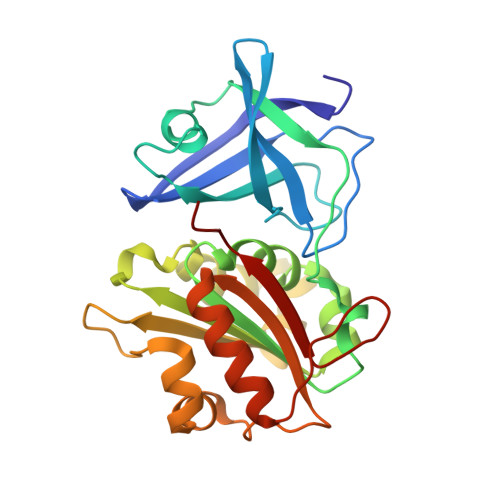Towards the competent conformation for catalysis in the ferredoxin-NADP+reductase from the Brucella ovis pathogen.
Perez-Amigot, D., Taleb, V., Boneta, S., Anoz-Carbonell, E., Sebastian, M., Velazquez-Campoy, A., Polo, V., Martinez-Julvez, M., Medina, M.(2019) Biochim Biophys Acta Bioenerg 1860: 148058-148058
- PubMed: 31394095
- DOI: https://doi.org/10.1016/j.bbabio.2019.148058
- Primary Citation of Related Structures:
6RR3, 6RRA - PubMed Abstract:
Brucella ovis encodes a bacterial subclass 1 ferredoxin-NADP(H) reductase (BoFPR) that, by similarity with other FPRs, is expected either to deliver electrons from NADPH to the redox-based metabolism and/or to oxidize NADPH to regulate the soxRS regulon that protects bacteria against oxidative damage. Such potential roles for the pathogen survival under infection conditions make of interest to understand and to act on the BoFPR mechanism. Here, we investigate the NADP + /H interaction and NADPH oxidation by hydride transfer (HT) to BoFPR. Crystal structures of BoFPR in free and in complex with NADP + hardly differ. The latter shows binding of the NADP + adenosine moiety, while its redox-reactive nicotinamide protrudes towards the solvent. Nonetheless, pre-steady-state kinetics show formation of a charge-transfer complex (CTC-1) prior to the hydride transfer, as well as conversion of CTC-1 into a second charge-transfer complex (CTC-2) concomitantly with the HT event. Thus, during catalysis nicotinamide and flavin reacting rings stack. Kinetic data also identify the HT itself as the rate limiting step in the reduction of BoFPR by NADPH, as well as product release limiting the overall reaction. Using all-atom molecular dynamics simulations with a thermal effect approach we are able to visualise a potential transient catalytically competent interaction of the reacting rings. Simulations indicate that the architecture of the FAD folded conformation in BoFPR might be key in catalysis, pointing to its adenine as an element to orient the reactive atoms in conformations competent for HT.
Organizational Affiliation:
Departamento de Bioquímica y Biología Molecular y Celular, Facultad de Ciencias, Universidad de Zaragoza, 50009 Zaragoza, Spain; Instituto de Biocomputación y Física de Sistemas Complejos (Joint Units: BIFI-IQFR and GBsC-CSIC), Universidad de Zaragoza, 50018 Zaragoza, Spain.

















